Playbill Collectibles : 1920 Playbill Price List
average value
-
low
-high
-Found 20 out of 56,978 items matching '1920'
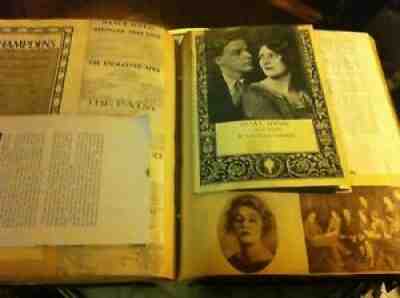
Sold on eBay Feb 09, 2021
BROADWAY SCRAPBOOK FROM ACTOR HOUSE B. JAMESON ESTATE 1920 S 100 PAGES,41 SIGNIT
,PHOTO'S, 100 PAGES ! He was chosen for the role because of his Texas background.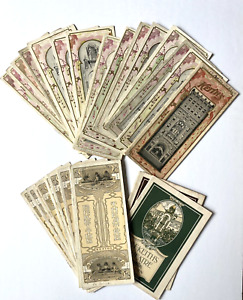
Sold on eBay April 6th, 2024
1900 Keith's Theater Program Lot Boston Houdini WC Fields Buster Keaton
Lot of 70 total antique playbills programs ranging from roughly 1900-1920, 25 programs for Keith's (B.F. Keith's) Theater in Boston MA. Incredible listings of productions, performers and advertising. Majority in excellent condition with staples secured, a few have some stains or a few loose pages. You can find Houdini, W.C. Fields and Buster Keaton amongst the lists plus so many others, for you to discover! Plus 45 programs from Worcester MA theaters early 1900s/turn of the century. Total 70 programs. Keith's Theatre (1894–1928) in Boston, Massachusetts, was a vaudeville playhouse run by B.F. Keith. It sat across from Boston Common in the city's theatre district on Tremont and Washington streets.Photos are of the actual item being sold and they are to be considered part of the description. We consider all offers in relation to current market values and we try to respond almost immediately. Your purchase will be packed carefully and shipped quickly. We are available 7 days a week. Please see other listings for books and collectibles that might be of interest to you and follow North Star Collectibles as we post new items every week.Thank you for looking and come again soon,North Star CollectiblesMember of the Ephemera Society of America and SNEAB Southern New England Antiquarian Booksellers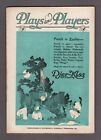
Sold on eBay May 8th, 2024
George Gershwin "DERE MABLE" George D. Cukor "BEN HUR" 1920 FLOP Tryout Program
This is a rare February 23rd, 1920 "Plays and "Players" program (playbill) from the two-week, out-of-town tryout of the ROSAMOND HODGES, EDWARD STREETER and JOHN HODGES musical comedy "DERE MABLE" at the Garrick Theatre in Philadelphia, Pennsylvania. (The production played two weeks in Philadelphia but closed on the road, cancelling the scheduled Broadway opening.) ..... Featuring three songs by GEORGE GERSHWIN (fifth scanned image)), the musical starred LOUIS BENNISON, JOHN JOHNSON, GEORGE ALLEN, RONALD ST. JOHN, PAUL HEPNER, future motion picture legend GEORGE D. CUKOR, ROBERT WOOLSEY, ELIZABETH HINES, SIDNEY REYNOLDS, CARL HALLER, HATTIE BURKS, FRANK WALZMAN, FRANK WALSH, JACK RUSSELL, JANET HORTON, EDWIN FORSBERG, SAM ASH, MAX MYERS, JACK RAFFAEL, GARRETT CARROLL, CERN PRENTICE, LILLIAN WELLS, GEORGIA SCOTT, ETHEL BURTON, KEWPIE COLLIER, FRANCES BURNS, MAY SHELDON, VIRGINIA LEE, RUTH ALEXANDER, GERTRUDE ORR, MAY SCOTT and SHIRLEY LOVE ..... Side note: Three of the songs, "Back Home", "We're Pals" and "I Want To Be Wanted By You" were composed by GEORGE GERSHWIN with lyrics by IRVING CAESAR (fifth scanned image) ..... CREDITS: Book and Lyrics by EDWARD STREETER and JOHN HODGES; Music composed by ROSAMOND HODGES; Additional Musical Numbers by GEORGE GERSHWIN ("Girl Crazy", "Lady, Be Good!", "Oh, Kay!", "Funny Face", "Rosalie", "Of Thee I Sing", "Porgy and Bess", "George White's Scandals"), IRVING CAESAR and LOUIS HARRISON; Scenery designed by HOMER EMENS; Costumes designed by SCHNEIDER ANDERSON; Choreographed by JOSEPH C. SMITH; Directed by GEORGE MARION; Produced by MARC KLAW ..... The program also includes the credits for the National Tour engagement of the General LEW WALLACE and WILLIAM YOUNG dramatic spectacle "BEN-HUR" at the Forrest Theatre in Philadelphia, Pennsylvania beginning February 23rd, 1920. (The Original Broadway production opened November 29th, 1899 at New York's Broadway Theatre and ran for 194 performances. The play would be revived five times on Broadway in the next seventeen years, would tour the United States, England and Australia for the next 21 years and would be seen by more than twenty million people.) ..... Based on General Lew Wallace's 1880 novel, the key spectacle of the show recreated the novel's chariot race with live horses and real chariots running on treadmills against a rotating backdrop. The play starred RICHARD BUHLER in the title role and featured CHARLES H. RIEGEL, JAMES BROWNING, FREDERICK A. ARTHUR, T. JEROME LAWLER, LESLIE STOWE, WILLIAM H. LEYDEN, JAMES W. HAYES, HARRY COWAN, EDGAR BRYDE, JOHN R. LINDSEY, GEORGE WILKES, ADRIEN BELLEVUE, CASSIUS C. QUIMBY, EARL N. PINGREE, FREDERICK S. WILSON, BISSELL PUTNAM, VIRGINIA HOWELL, PEGGY MAY, LAURA BURT, THERESE MEEHAN and STELLA BONIFACE WEAVER ..... CREDITS: Original Book by General LEW WALLACE; Arranged for the Stage by WILLIAM YOUNG; Vocal and Instrumental Music composed by EDGAR STILLMAN KELLEY; Scenery designed by ERNEST ALBERT and ERNEST GROS; Costumes designed by F. RICHARD ANDERSON; Directed by JOSEPH BROOKS; Produced by KLAW and ERLANGER ..... The program also includes the credits for the National Tour engagement of ROBERT B. MANTELL in a repertoire of WILLIAM SHAKESPEARE and other classics at the Forrest Theatre in Philadelphia, Pennsylvania beginning February 23rd, 1920 ..... The engagement included performances of Shakespeare's "THE MERCHANT OF VENICE", "JULIUS CAESAR", "HAMLET", "MACBETH" and Sir Edward Bulwer Lytton's "RICHELIEU" and each production starred Mr. ROBERT B. MANTELL, FRITZ LEIBER and Miss GENEVIEVE HAMPER. The remaining members of the company included ABRAHAM IVORY, C. PORTER HALL, VAUGHAN DEERING, GUY LINDSLEY, GEORGE WILSON, HENRY BUCKLER, JOHN ALEXANDER, GEORGE STILLWELL, FRANKLIN SALISBURY, EDWIN FOOS, EDWARD LEWERS, LAWRENCE KREY, THOMAS LEAR, VIRGINIA BRONSON, ROY CLIFFORD, LINLEY HUBBELL, GILBERT SELLS, JAMES GRAY, FRANCES LOUGHTON, GUY HAWKS, JAMES KEENE, CAROLINE CONNOR, BESSIE JAMES and FRANK BARRY ..... CREDITS: Book by WILLIAM SHAKESPEARE; Sets designed by SIGNOR MOLTENI; Costumes designed by Miss GREHEA; Produced and Directed by ROBERT B. MANTELL ..... Side note: ROBERT B. MANTELL was the Great-Uncle of ANGELA LANSBURY ..... DETAILS: The 36 page program measures 5 1/2" X 7 7/8" inches and includes full production credits, cast lists, synopsis of scenes, list of musical numbers, promotional text and wonderful vintage advertising, but no cast photos or bios ..... CONDITION: With the exception of a vertical fold and moderate edge wear, this rare program is in excellent condition and will make a wonderful addition to the collection of any theatre aficionado or historian. This item will be carefully packaged in a protective, carded sleeve and backed by stiff cardboard.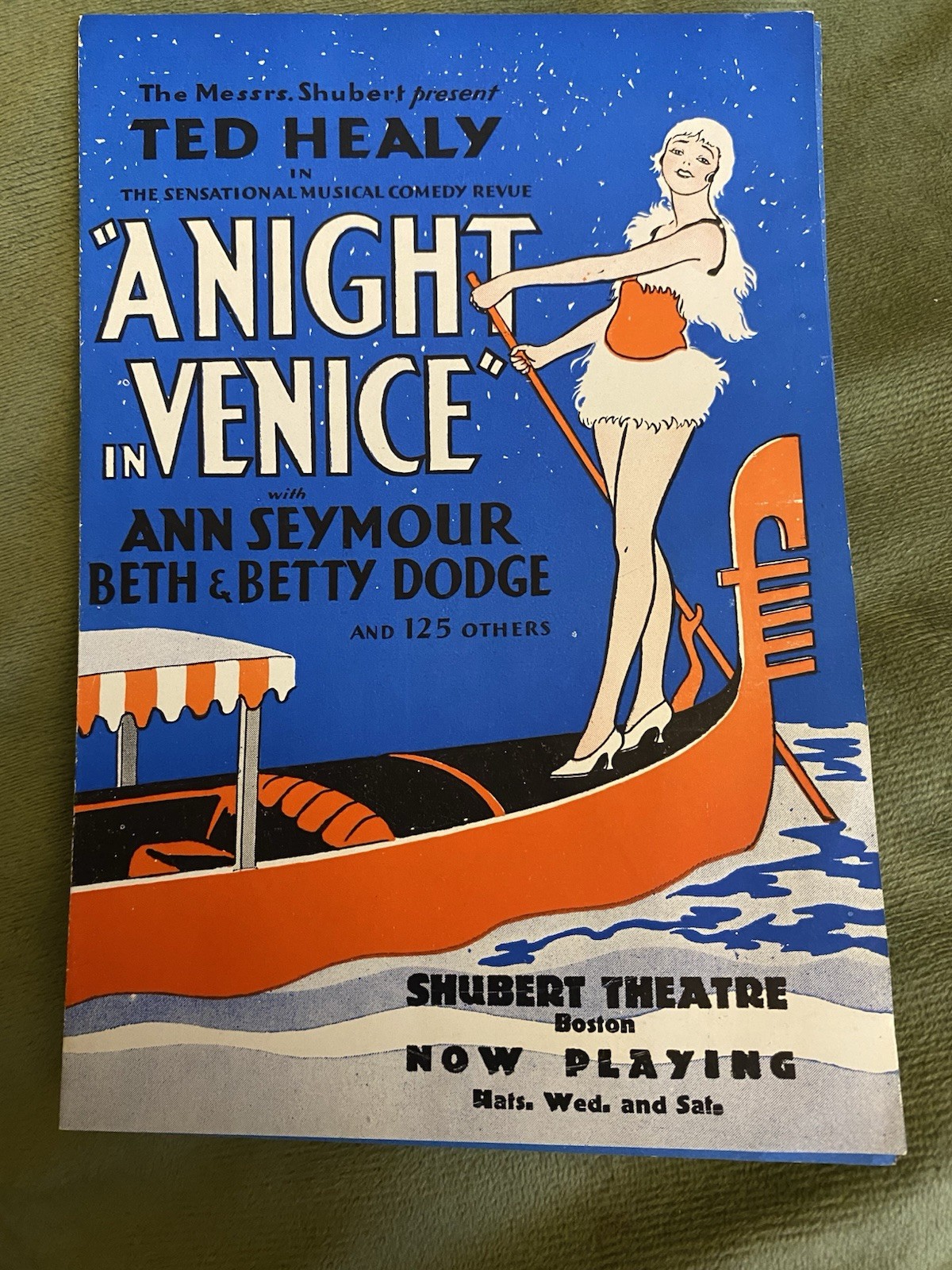
Sold on eBay April 1st, 2025
Three Stooges "A NIGHT IN VENICE Ted Healy / Shemp Howard 1929 Antique Playbill
Immerse yourself in the nostalgia of early 20th-century theater with this authentic Ted Healy - Three Stooges "A NIGHT IN VENICE" playbill. Featuring the comedic genius of Ted Healy and Moe and Shemp Howard and Larry Fine - this antique piece hails from the transformative era of 1920-1929, offering a glimpse into the vibrant Broadway musical revue scene of the time. Very rare Three Stooges collectible at the absolute beginning of their illustrious career. The addition of Larry Fine happened with this Play. Moe, Shemp and Larry were the first iteration of the Three Stooges. This is near impossible to find and in near mint condition. I hope it is a must have for a lucky fan. I welcome serious offers. Crafted in the United States, this original playbill is a treasure for collectors and enthusiasts alike. It represents not only a piece of entertainment history but also a tangible artifact from the Theater industry's golden age. A must-have for those who cherish the rich heritage of American performance art.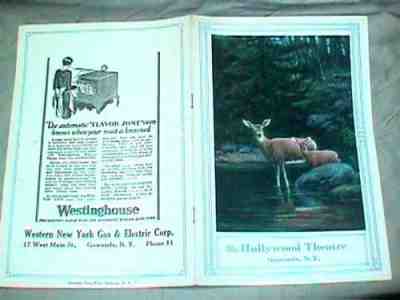
Sold on eBay Aug 15, 2022
1920's 1930's HOLLYWOOD THEATRE PROGRAM Book GOWANDA NY PICTURE DEER Greta GARBO
DEER Greta GARBO John GILBERT Photo Jun 3-8.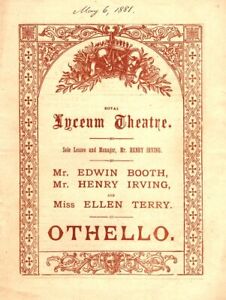
Sold on eBay August 22nd, 2023
*STAGE LEGENDS EDWIN BOOTH HENRY IRVING ELLEN TERRY RARE 1881 OTHELLO PROGRAM*
It's one of the most historic productions in the history of the stage. A rare original May 6, 1881 second night program for Edwin Booth, Henry Irving, and Ellen Terry in Othello at the Lyceum Theatre. Booth and Irving alternated Othello and Iago, with Booth here playing Othello in the first week of the run. Future playwright Arthur Wing Pinero plays Roderigo. Future Dracula author Bram Stoker is listed as acting manager. Four pages. Dimensions eight and a quarter by six and a quarter inches. Light wear, light fold, and soiling otherwise good. See the Edwin Booth, Henry Irving, and Ellen Terry's extraordinary biographies below. Ships first class insured in US and airmail overseas. Shipping discounts for multiple purchases. Inquiries always welcome. Please visit my other eBay items for more early theatre, opera, film, magic, and historical autographs, photographs, programs and broadsides and great actor and actress cabinet photos and CDV's. From Wikipedia: The Booth family was an English American theatrical family of the 19th century. Its most famous and well known members were Edwin Booth, one of the leading actors of his day, and John Wilkes Booth, who assassinated Abraham Lincoln. The patriarch was Junius Brutus Booth, a London-born lawyer's son who eventually became an actor after he attended a production of Othello at the Covent Garden theatre. The prospects of fame, fortune and freedom were very appealing to young Booth, and he displayed remarkable talent from an early age, deciding on a career in the theatre by the age of seventeen. He performed roles in several small theaters throughout England, and joined a tour of the Low Countries in 1814, returning the following year to make his London debut. Booth abandoned his wife and their young son in 1821 and ran off to the United States with Mary Ann Holmes, a London flower girl. They settled in Harford County near Baltimore, and built a house named "Tudor Hall" in 1847, which still survives. There they started a family; they had ten children, six of whom survived to adulthood [1][2] Junius Sr. and Edwin toured the Western United States during the Gold Rush, performing plays by Shakespeare for illiterate miners, who nevertheless had no tolerance for bad acting. Edwin Booth bought an interest in the Winter Garden Theatre at 667 Broadway in New York City together with his brother-in-law John Sleeper Clarke. The brothers John Wilkes, Edwin, and Junius Brutus, Jr. performed there in the play Julius Caesar at a benefit in 1864, the only time they were seen together on a stage, playing Mark Antony, Brutus and Cassius, respectively. Edwin Thomas Booth (November 13, 1833 – June 7, 1893) was a famous 19th-century American actor who toured throughout America and the major capitals of Europe, performing Shakespearean plays. In 1869 he founded Booth's Theatre in New York, a spectacular theatre that was quite modern for its time.[2] Some theatrical historians consider him the greatest American actor, and the greatest Hamlet, of the 19th century.[3] However, his achievements are often overshadowed by his relationship with his brother, John Wilkes Booth, the man who assassinated President Abraham Lincoln.Sir Henry Irving (6 February 1838 – 13 October 1905), born John Henry Brodribb, sometimes known as J. H. Irving, was an English stage actor in the Victorian era, known as an actor-manager because he took complete responsibility (supervision of sets, lighting, direction, casting, as well as playing the leading roles) for season after season at the Lyceum Theatre, establishing himself and his company as representative of English classical theatre. In 1895 he became the first actor to be awarded a knighthood, indicating full acceptance into the higher circles of British society.Irving is widely acknowledged to be one of the inspirations for Count Dracula, the title character of the 1897 novel Dracula whose author, Bram Stoker, was business manager of the theatre.Dame Alice Ellen Terry, GBE (27 February 1847[1] – 21 July 1928), known professionally as Ellen Terry,[2] was a renowned English actress of the late 19th and early 20th centuries.Born into a family of actors, Terry began performing as a child, acting in Shakespeare plays in London, and toured throughout the British provinces in her teens. At 16, she married the 46-year-old artist George Frederic Watts, but they separated within a year. She soon returned to the stage but began a relationship with the architect Edward William Godwin and retired from the stage for six years. She resumed acting in 1874 and was immediately acclaimed for her portrayal of roles in Shakespeare and other classics.In 1878 she joined Henry Irving's company as his leading lady, and for more than the next two decades she was considered the leading Shakespearean and comic actress in Britain. Two of her most famous roles were Portia in The Merchant of Venice and Beatrice in Much Ado About Nothing. She and Irving also toured with great success in America and Britain.In 1903 Terry took over management of London's Imperial Theatre, focusing on the plays of George Bernard Shaw and Henrik Ibsen. The venture was a financial failure, and Terry turned to touring and lecturing. She continued to find success on stage until 1920, while also appearing in films from 1916 to 1922. Her career lasted nearly seven decades.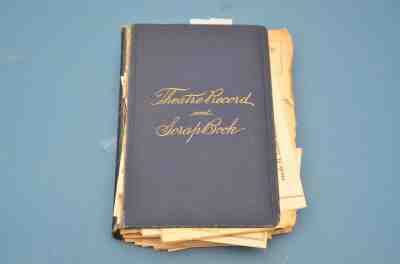
Sold on eBay Aug, 29th 2020
St. Louis Area Theater Playbill & Broadside Scrapbook 1890's-1930's 115 pieces
This sale is for a vintage scrap book of playbills and broadside advertisements from plays that were performed in the St. Louis area. I see dates as far back as 1989, and into the 1930's. I would say the majority are form the 1920's and 1930's. I do not know the history, if the person who collected this was a fan of the theater, or a performer, or in some other way associated with the theater. I carefuly looked through the book, and counted 115 pieces. Most are complete and in good shape. Some have come loose from the staple that was holding the playbill together. These have great advertising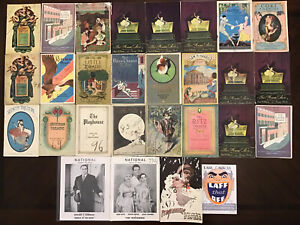
Sold on eBay September 24th, 2023
Huge LOT ~ 26 Vintage Broadway PLAYBILLS 1920s ~ Crime Courage Wisdom Tooth More
Huge LOT of 26 Vintage Broadway PLAYBILLS from 1920s + 2 ProgrammesOne Night in Rome, 1919, Criterion Theatre, NYThy Name is Woman, 1920, The Playhouse, NYGood Morning Dearie, 1921, Globe Theatre, NYThe First Year, 1921, The Little Theatre, NYWelcome Stranger, 1921, Sam H. Harris Theatre, NYKiki, 1922, Belasco Theatre, NYMusic Box Revue, 1922, The Music Box, NYCaptain Applejack, 1922, Cort Theatre, NYSecrets, 1923, Fulton Theatre, NYEasy Virtue, 1925, Empire Theatre, NYCradle Snatchers, 1925, The Music Box, NYTwo Girls Wanted, 1926, The Little Theatre, NYA Lady’s Virtue, 1926, Bijou Theatre, NYLulu Belle, 1926, Belasco Theatre, NYThe Wisdom Tooth, 1926, The Little Theatre, NYCrime, 1927, Times Square Theatre, NYNightstick, 1927, Selwyn Theatre, NYParis Bound, 1928, The Music Box, NYParis, 1929, The Music Box, NYCourage, 1929, The Ritz Theatre, NYMy Girl Friday, 1929, The Republic Theatre, NYThe Little Show, 1929, The Music Box, NYTopaze, 1930, The Music Box, NYWaterloo Bridge, 1930, Fulton Theatre, NYTime Remembered, 1957, National Theatre, NYMiddle of the Night, 1958, National Theatre, NYShipped with USPS Media Mail.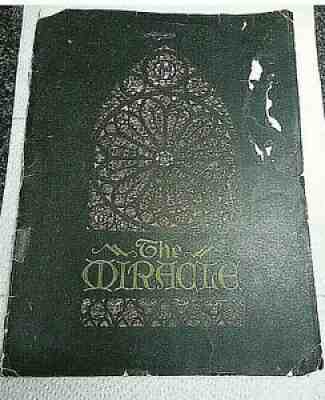
Sold on eBay Oct 20, 2020
1920's Memorabilia. Autogrphd Playbill, Photos, Sketching, etc. of Artist Jacoby
GRAZEILLA JACOBY'S 1926 MULTI AUTOGRAPHED PLAYBILL OF MAX REINHARDT'S "THE MIRICLE". Ms. Jacoby was a popular fashion illustrator in the 1920s. WATER MARK IS NOT ON ACTUAL PHOTO . The pencil drawing (with her initial signature) is believed to be of her father.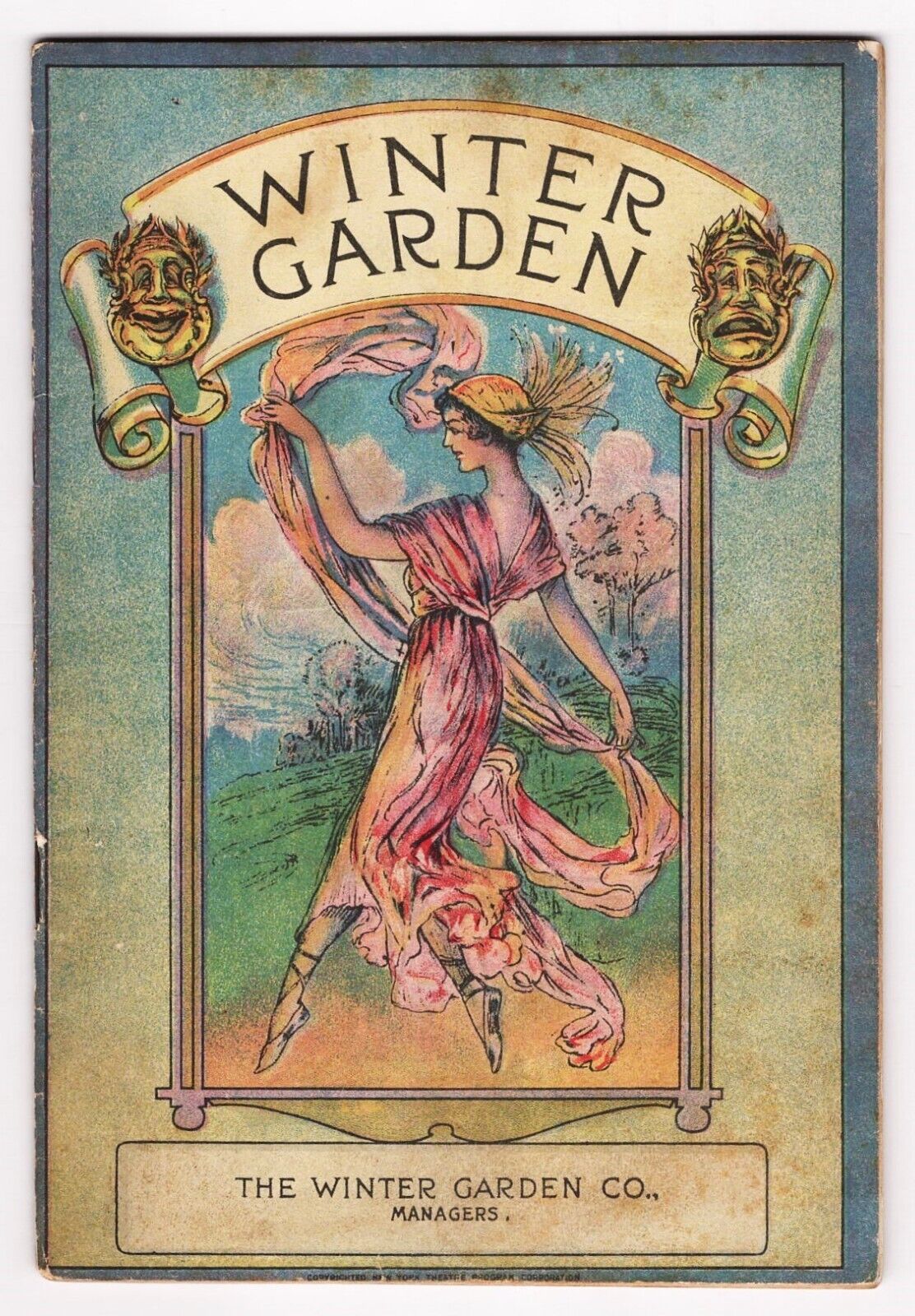
Sold on eBay December 20th, 2024
George Gershwin "BROADWAY BREVITIES" Eddie Cantor / Bert Williams 1920 Playbill
This is a rare October 11th, 1920 program (playbill) from the opening weeks of the Original Broadway production of the musical revue "GEORGE LeMAIRE'S BROADWAY BREVITIES 1920" at the Winter Garden Theatre in New York City. (The production opened September 29th, 1920 and closed December 18th, 1920 after 105 performances.) ..... The revue starred GEORGE LeMAIRE, BERT WILLIAMS, EDDIE CANTOR and EDITH HALLOR and the cast included HAL VAN RENSELLEAR, TECK MURDOCK, VIRGINIA ROCHE, PEGGY MITCHELL, ALVAH FENTON, ONA HAMILTON, EDDIE BUZZELL, PEGGY PARKER, GENEVIEVE HOUGHTON, BETTIE PARKER, JAY DILLON, NATALIE KINGSTON, ULA SHARON, WILLIAM SULLY, PAUL VAN DYKE, ALEXIS KOSLOFF, MARCELLE BARNES, FLORENCE KERN, ..... CREDITS: Music and Lyrics by GEORGE GERSHWIN ("Girl Crazy", "Lady, Be Good!", "Oh, Kay!", "Funny Face", "Rosalie", "Strike Up the Band", "Of Thee I Sing", "Porgy and Bess", "George White's Scandals"), BLAIR TREYNOR, ARCHIE GOTTLER and ARTHUR JACKSON; Additional Songs by BERT KALMAR and HARRY RUBY, BERT WILLIAMS, JOSEPH M. DALY and IRVING BERLIN ("Annie Get Your Gun", "Music Box Revues", the Marx Brothers' "The Cocoanuts", "Louisiana Purchase", "This is the Army", "Miss Liberty", "Call Me Madam", "Mr. President"); Orchestra conducted by LOUIS GRESSE; Art Direction by HERBERT WARD; Sets designed by H. ROBERT LAW STUDIOS; Costumes designed by CHARLES LeMAIRE; Choreography by JACK MASON; Staged by J. C. HUFFMAN; Produced by RUFUS LeMAIRE ..... DETAILS: The 52 page playbill measures 5 1/4" X 7 5/8" inches and includes full production credits, cast list, scenes, musical numbers and wonderful vintage advertising, but no cast photos or bios ..... CONDITION: (Please Note!) There is soiling to the covers, a corner crease to the back cover and moderate edge wear. Despite these flaws, this rare playbill will make a wonderful addition to the collection of any musical theatre aficionado or historian. This item will be carefully packaged in a protective, carded sleeve and backed by stiff cardboard.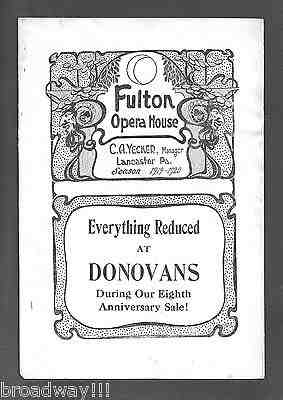
Sold on eBay Apr, 8th 2020
George Gershwin (First Score) "LA, LA, LUCILLE" Buddy G. DeSylva 1920 Program
This is a rare January 24th, 1920program (playbill) from nbsp;the nbsp;one night Post-Broadway engagementof the GEORGE GERSHWIN, FRED JACKSON, ARTHUR J. JACKSON nbsp;and nbsp;BUDDY G. DeSYLVAmusical farce comedy "LA, LA, LUCILLE" at the Fulton Opera House in Lancaster, Pennsylvania. (The production opened May 26th, 1919 at Henry Miller s nbsp;Theatre in New York City and ran for 104 performances before going on the road ) nbsp; nbsp;The musical was significant as itfeatured GEORGE GERSHWIN's first full Broadway score (though none of the creativ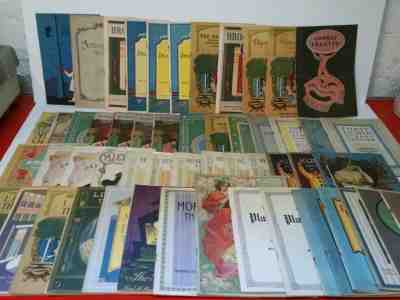
Sold on eBay Aug, 31st 2020
THEATER MEMORABILIA PLAYBILLS PRE-1940 LARGE COLLECTION 54 PROGRAMS MULTI SITES
THIS AUCTION IS FOR A VINTAGE COLLECTION OF 54 THEATRE PLAYBILLS FROM THE 1920'S...FROM A VERY LARGE VARIETY OF NEW YORK THEATRES. ..<br />PLEASE USE PHOTOS TO SEE THE COLLECTION IN ITSENTIRETY PHOTOS SHOW THE SELECTIONS YOU WILL RECEIVE...A NO RESERVE AUCTION.<br THEATRES: nbsp;TIME SQUARE...SAM S. SHUBERT PLYMOUTH PLAYHOUSE ORPHEUM MOROSCO MUSIC BOX...MAXINE ELLIOTT S LIBERTY LITTLE KNICKERBOCKER KLAW HENRY MILLER S GAIETY GLOBE FRAZEE FORTY EIGHTH STREET...44TH STREET...39TH STREET...49TH STREET FULTON EMPIRE ELTINGE CRITERION COMEDY BIJOU BR
Sold on eBay October 5th, 2023
*A CONAN DOYLE JAMES O'NEILL CRESTON CLARKE 1903 ADVENTURES OF GERARD PROGRAM*
A rare original program clip circa 1903 for James O'Neill--Eugene O'Neill's father--and Creston Clarke, nephew of Edwin and John Wilkes Booth, in Sherlock Holmes author A. Conan Doyle's The Adventures of Gerard. Laid down to an Edwardian album page. Dimensions seven by four inches. Light wear otherwise good. See the story of Brigadier Gerard and A. Conan Doyle's extraordinary biography below. Shipping discounts for multiple purchases. Inquiries always welcome. Please visit my other eBay items for more early Gilbert and Sullivan items, theatre, opera, film and historical autographs, photographs and programs, and great actor and actress cabinet photos and CDV's. Sir Arthur Ignatius Conan Doyle KStJ DL (22 May 1859 – 7 July 1930) was a British writer and physician. He created the character Sherlock Holmes in 1887 for A Study in Scarlet, the first of four novels and fifty-six short stories about Holmes and Dr. Watson. The Sherlock Holmes stories are milestones in the field of crime fiction.Doyle was a prolific writer; other than Holmes stories, his works include fantasy and science fiction stories about Professor Challenger and humorous stories about the Napoleonic soldier Brigadier Gerard, as well as plays, romances, poetry, non-fiction, and historical novels. One of Doyle's early short stories, "J. Habakuk Jephson's Statement" (1884), helped to popularise the mystery of the Mary Celeste.His first work featuring Sherlock Holmes and Dr. Watson, A Study in Scarlet, was written in three weeks when he was 27 and was accepted for publication by Ward Lock & Co on 20 November 1886, which gave Doyle £25 (equivalent to £2,900 in 2019) in exchange for all rights to the story. The piece appeared a year later in the Beeton's Christmas Annual and received good reviews in The Scotsman and the Glasgow Herald [9]Holmes was partially modelled on Doyle's former university teacher Joseph Bell. In 1892, in a letter to Bell, Doyle wrote, "It is most certainly to you that I owe Sherlock Holmes ... round the centre of deduction and inference and observation which I have heard you inculcate I have tried to build up a man",[35] and in his 1924 autobiography, he remarked, "It is no wonder that after the study of such a character [viz., Bell] I used and amplified his methods when in later life I tried to build up a scientific detective who solved cases on his own merits and not through the folly of the criminal."[36] Robert Louis Stevenson was able to recognise the strong similarity between Joseph Bell and Sherlock Holmes: "My compliments on your very ingenious and very interesting adventures of Sherlock Holmes. ... can this be my old friend Joe Bell?"[37] Other authors sometimes suggest additional instance, Edgar Allan Poe's character C. Auguste Dupin, who is mentioned, disparagingly, by Holmes in A Study in Scarlet.[38] Dr. (John) Watson owes his surname, but not any other obvious characteristic, to a Portsmouth medical colleague of Doyle's, Dr. James Watson [39]Sherlock Holmes statue in Edinburgh, erected opposite the birthplace of Doyle, which was demolished c. 1970A sequel to A Study in Scarlet was commissioned, and The Sign of the Four appeared in Lippincott's Magazine in February 1890, under agreement with the Ward Lock company. Doyle felt grievously exploited by Ward Lock as an author new to the publishing world, and so, after this, he left them.[9] Short stories featuring Sherlock Holmes were published in the Strand Magazine. Doyle wrote the first five Holmes short stories from his office at 2 Upper Wimpole Street (then known as Devonshire Place), which is now marked by a memorial plaque [40]Doyle s attitude towards his most famous creation was ambivalent.[39] In November 1891, he wrote to his mother: "I think of slaying Holmes, ... and winding him up for good and all. He takes my mind from better things." His mother responded, "You won't! You can't! You mustn't!"[41] In an attempt to deflect publishers' demands for more Holmes stories, he raised his price to a level intended to discourage them, but found they were willing to pay even the large sums he asked.[39] As a result, he became one of the best-paid authors of his time.Statue of Holmes and the English Church in MeiringenIn December 1893, to dedicate more of his time to his historical novels, Doyle had Holmes and Professor Moriarty plunge to their deaths together down the Reichenbach Falls in the story "The Final Problem". Public outcry, however, led him to feature Holmes in 1901 in the novel The Hound of the Baskervilles. Holmes's fictional connection with the Reichenbach Falls is celebrated in the nearby town of Meiringen.In 1903, Doyle published his first Holmes short story in ten years, "The Adventure of the Empty House", in which it was explained that only Moriarty had fallen, but since Holmes had other dangerous Colonel Sebastian Moran—he had arranged to make it look as if he too were dead. Holmes was ultimately featured in a total of 56 short stories—the last published in 1927—and four novels by Doyle, and has since appeared in many novels by other authors Brigadier Gerard is the comedic hero of a series of 17 historical short stories, a play, and a major character in a novel by the British writer Arthur Conan Doyle. Brigadier Etienne Gerard is a Hussar officer in the French Army during the Napoleonic Wars. Gerard's most notable attribute is his vanity – he is utterly convinced that he is the bravest soldier, greatest swordsman, most accomplished horseman and most gallant lover in all France. Gerard is not entirely wrong, since he displays notable bravery on many occasions, but his self satisfaction undercuts this quite often. Obsessed with honour and glory, he is always ready with a stirring speech or a gallant remark to a lady.Doyle, in making his hero a vain, and often rather uncomprehending Frenchman, was able to satirise both the stereotypical English view of the French and – by presenting them from Gerard's baffled point of view – English manners and attitudes.The Booth family was an English American theatrical family of the 19th century. Its most known members were Edwin Booth, one of the leading actors of his day, and John Wilkes Booth, who assassinated Abraham Lincoln.The patriarch was Junius Brutus Booth, a London-born lawyer's son who eventually became an actor after he attended a production of Othello at the Covent Garden theatre. The prospects of fame, fortune, and freedom were very appealing to young Booth, and he displayed remarkable talent from an early age, deciding on a career in the theatre by the age of 17. He performed roles in several small theaters throughout England, and joined a tour of the Low Countries in 1814, returning the following year to make his London debut.Booth abandoned his wife and their young son in 1821 and ran off to the United States with Mary Ann Holmes, a London flower girl. They settled on some 150 acres in Harford County near Baltimore and started a family; they had 10 children, six of whom survived to adulthood [1][2]Junius Sr. and Edwin toured in California during the Gold Rush.[citation needed] Edwin bought an interest in the Winter Garden Theatre at 667 Broadway in New York City with his brother-in-law John Sleeper Clarke. The brothers John Wilkes, Edwin, and Junius Brutus, Jr. performed there in the play Julius Caesar at a benefit in 1864, the only time they were seen together on a stage, playing Mark Antony, Brutus, and Cassius, respectively [3]MembersThe Booth Family gravesite, Green Mount CemeteryJunius Brutus Booth (1796–1852) brought his mistress Mary Ann Holmes, who bore him 10 children, to the United States.He also wrote many letters in fits of drunken anger and madness to President Andrew Jackson threatening assassination. He requested that two prisoners who had been sentenced to death for piracy, named De Ruiz and De Soto, be pardoned, or else: "I will cut your throat whilst you are sleeping." This letter would later be recanted by Junius, stating, "May god preserve General Jackson and this happy republic [4]Junius Brutus Booth Jr. (1821–1883) was married to Agnes Booth. Junius Jr. never achieved the same fame as his brothers, but his third wife Agnes was popular.Their son Sydney Barton Booth (1877–1937) was an actor well into the era of modern film [5]Edwin Thomas Booth (1833–1893) came to be the foremost American Shakespearean actor of his day. He founded The Players, a New York City actors' club which continues to the present day. His second wife, Mary McVicker, was an actress [6]Edwin s grandson Edwin Booth Grossman was a painter of some note.Asia Frigga Booth (1835–1888) married John Sleeper Clarke, an actor/comedian who was briefly imprisoned in the aftermath of the assassination. They then emigrated to Britain, where he became a successful theatre manager.Creston Clarke[7] and Wilfred Clarke,[8] sons of John and Asia, were noted actors in their day.John Wilkes Booth (1838–1865) was a popular young star in less serious fare than his brothers.A Confederate sympathizer during the American Civil War, during a play attended by Abraham Lincoln, Booth took advantage of his access to the theatre to invade the President's box and assassinate the President. He was killed 12 days later by Union soldier Boston Corbett.Edwina Booth Grossman (1861–1938) daughter of Edwin Booth,[9] and the author of Edwin Booth: Recollections by His Daughter, Edwina Booth Grossman, and Letters to Her and to His Friends (1894).James O'Neill (November 15, 1847 – August 10, 1920) was an Irish-American theatre actor and the father of the American playwright Eugene O'Neill.Early lifeJames O'Neill[1] was born on November 15, 1847, in County Kilkenny, Ireland. His parents were distant cousins, Edward[2] and Mary O'Neill. His father was a farmer. The family emigrated to America in 1851 and settled in Buffalo, New York. In 1857 they moved to Cincinnati, Ohio, where James was apprenticed to a machinist [3]CareerPlaque in New Ross, County Wexford recalling his emigration to America in 1851At the age of 21, he made his stage debut in a Cincinnati, Ohio, production of Boucicault's The Colleen Bawn (1867). Also in 1867, Edwin Forrest embarked on a "farewell tour". O'Neill had a minor part in Forrest's Cincinnati production of Virginius, and then joined a travelling repertory company. He played a young sailor in Joseph Jefferson's Rip Van Winkle and for the first time found his brogue a handicap.[3] He also played Macduff to Edwin Booth's Macbeth.The San Francisco Chronicle of August 3, 1879, described James O'Neill as "...a quiet gentleman of medium height, well proportioned figure, square shoulders and stands very erect. He has black hair, black eyes, rather dark complexion, a black mustache, and a fine set of teeth which he knows how to display to advantage."[3] "[4]While in San Francisco, O'Neill became friends with fellow actor, John Elitch. When Elitch opened the Elitch Zoological Gardens in Denver, Colorado, on May 1, 1890, O'Neill attended the opening and promised "I'll come back and play on that stage whenever you say." On May 30, 1897, O'Neill kept his promise and appeared in the opening play, Helene, by Martha Morton.[5]He was considered a promising actor, quickly working his way up the ranks to become a matinee idol. [6]ScandalIn 1874 O'Neill joined Richard M. Hooley's company, and the following year toured San Francisco, Virginia City and Sacramento. He then headed back east to join the Union Square Company.[3]On June 14, 1877, while in New York, James O'Neill married Mary Ellen Quinlan, daughter of Thomas and Bridget Quinlan, at St. Ann's Church on 12th Street. James and Ella had three sons: James (b. 1878), Edmund (b. 1883) and Eugene O'Neill (b. 1888). While James was on tour, Ella often accompanied him, and the boys were placed in boarding school. In the fall of 1877, three months after James' marriage, a woman by the name of Nettie Walsh sued O'Neill, claiming that O'Neill already married her, when she was 15, and he was the father of her three year old son. [4]The couple was in San Francisco on September 10, 1878, when their first son, James O'Neill, Jr. was born in the home of one of O'Neill's friends. While in San Francisco, O'Neill took on the role of Christ in David Belasco's production The Passion for which Belasco rounded up 100 nursing mothers to appear in the tableau "the Massacre of the Innocents". The Board of Supervisors passed a local ordinance prohibiting "profane" dramas, and O'Neill and the rest of the company were arrested. O'Neill pleaded guilty and paid a $50 fine for himself and $5 for each of his co-defendants. About October 30, 1880, O'Neill and his family took a train back to New York where he re-joined the Union Square Company.[3]The Count of Monte CristoPoster for a 1900 theatre production of Monte Cristo, adapted for the stage by Charles Fechter, starring James O'NeillEdmond Dantès (James O'Neill) loosens a stone before making his escape from the Château d'If in The Count of Monte Cristo (1913)As early as 1875, while a stock star at Hooley's Theatre in Chicago, O'Neill played the title role in a stage adaptation of Dumas' The Count of Monte Cristo. In early 1883 O'Neill took over the lead role in Monte Cristo at Booth's Theater in New York, after Charles R. Towne died suddenly in the wings after his first performance. O'Neill's interpretation of the part caused a sensation with the theater-going public. A company was immediately set up to take the play on tour. O'Neill bought the rights to the play. The San Francisco News Latter was less appreciative of O'Neill, saying on December 31, 1887 "In his hands the romantic story has degenerated into an extravagant melodrama. ...He is reaping the pecuniary profit of his business sagacity, but it is at the cost of art."[3]O'Neill soon had enough of the Count. His lines came out by rote and his performances became lackadaisical. He tried other plays but The Three Musketeers and Julius Caesar met with indifferent response, and O'Neill was forced to return to Monte Cristo in order to recoup the losses sustained in "artistic successes". Monte Cristo remained a popular favorite and would continue to make its appearance on tour as regular as clockwork. O'Neill could not afford to sacrifice wealth in the face of a growing family. His son Eugene was born in New York on October 16, 1888.[3]He went on to play this role over 6000 times. Some, including Eugene, saw O'Neill's willingness to play the role so many times as selling out; squandering the potential of his art in order to make money.[7] By 1887, The San Francisco Morning Call estimated O'Neill's fortune at a quarter of a million dollars. In March 1894, O'Neill took on the role of Shane O'Neill in the play The Prince of Ulster [3]According to his son, Eugene,My father was really a remarkable actor, but the enormous success of "Monte Cristo" kept him from doing other things. He could go out year after year and clear fifty thousand in a season. He thought that he simply couldn't afford to do anything else. But in his later years he was full of bitter regrets. He felt "Monte Cristo" had ruined his career as an artist.[3]The company toured as far west at St. Louis; Eugene O'Neill who had given up his studies at Princeton, was the assistant treasurer. He left the company to begin his wanderings at sea.[3] O'Neill converted "Monte Cristo" into tabloid form for the vaudeville circuit to accommodate changing taste in theater entertainment O Neill s celebrity and identification with Monte Cristo led Adolph Zukor to engage O'Neill in 1912 to appear in a feature film version of the play as the first production of his Famous Players Film Company. By that time O'Neill had been continuously playing the part for nearly 40 years and was 65 years old. Directed and photographed by Edwin S. Porter and co-starring Nance O'Neil as Mercedes, the film was initially held back in release but finally appeared in late 1913.DeathIn the middle of 1920 James was struck by an automobile in New York City and taken to Lawrence Memorial Hospital in New London, Connecticut. He died, aged 72, on August 11, 1920, from intestinal cancer,[4] at the family summer home, the Monte Cristo Cottage in Connecticut. His funeral at St. Joseph's Church was attended by, among others, O'Neill's sister, Mrs. M. Platt of St. Louis and Edward D. White, Chief Justice of the United States Supreme Court. O'Neill was buried in St. Mary's cemetery [3]LegacyJames O'Neill later became the model for James Tyrone, the frugal, mercurial, unseeing father character in Eugene O'Neill's posthumously published play Long Day's Journey into Night, which tells the story of the Tyrone family, which closely resembles the O'Neill family.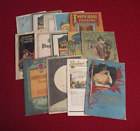
Sold on eBay September 14th, 2024
Lot of 14 Vintage Broadway Playbills and Theater Programs from the 1920's
Lot of 14, theater programs and Playbills from the 1920's.These are all in good condition for their age. Some have some creasing to the corners but overall, a decent lot. Free shipping.
Sold on eBay May 11th, 2024
Reginald De Koven (Debut) "THE BEGUM" Harry B. Smith 1887 Chicago Broadside
This is a rare December 26th, 1887 broadside (single page playbill) from the two-week, Post-Broadway engagement of the McCaull Opera Company in the REGINALD DE KOVEN and HARRY B. SMITH Hindu Comic Opera "THE BEGUM" at the Chicago Opera House in Chicago, Illinois. (The production opened September 21st, 1887 at the Fifth Avenue Theatre in New York City and ran for 22 performances before going on the road.) ..... The ensemble cast included MATHILDE COTTRELLY, DE WOLF HOPPER, EDWIN W. HOFF, HUBERT WILKE, DIGBY BELL, MARION MANOLA, J. DE ANGELIS, HARRY MacDONOUGH, LAURA JOYCE-BELL, ANNIE MYERS, JOSEPHINE KNAPP, NINA BERTINI, GRACE SEAVEY and TOLIE PETTIT ..... Biographical Note: Henry Louis Reginald De Koven (April 3rd, 1859 – January 16th, 1920) was an American music critic, conductor, and prolific composer, particularly of comic operas, who helped establish the style of American light opera. De Koven was born in Middletown, Connecticut, but in 1870, when Reginald was eleven, the family moved to England, where he received the majority of his education. He graduated from St John’s College of Oxford University in England in 1879 and undertook various musical studies in Stuttgart, Germany. De Koven returned to the U.S. in 1882 to live in Chicago, Illinois, where he worked in a brokerage firm until his marriage to Anna Farwell, and later lived in New York City. In 1883, De Koven started a dry-goods business that became very successful. With the steady income, he was able to return to music. He was able to find scope for his wide musical knowledge as a critic with Chicago’s "Evening Post", "Harper’s Weekly", and the "New York World". Between 1887 and 1913, De Koven composed twenty light operas, beginning with "The Begum" in1887 (libretto by Harry B. Smith), in addition to hundreds of songs (over 450), orchestral works, two piano sonatas, and ballets. The following year he again teamed with Smith to compose the opera "Don Quixote". From 1902 to 1904, De Koven conducted the Washington, D.C. Symphony, which he helped organize. De Koven’s greatest success was "Robin Hood", also with libretto by Harry B. Smith, which premiered at the Chicago Opera House on June 9th 1890 but was performed all across the country and received more than 3,000 performances. It played in New York at the Standard Theatre in 1891 and in London the same year, retitled "Maid Marian", and it continued to be revived for many years. Many of his songs became popular, especially “Oh Promise Me” from "Robin Hood", with words by Clement Scott, which was one of the biggest song successes of its time and remains a wedding standard. (Reprinted in part from the Walker Home School website) ..... CREDITS: Music composed by REGINALD DE KOVEN (Professional Debut); Libretto by HARRY B. SMITH; Costumes designed by MATHILDE COTTRELLY; Staged by JOHN A. McCAULL; Produced by the McCAULL OPERA COMPANY ..... DETAILS: The single page, one-sided program measures 5 1/8" X 7 3/4" inches and includes production credits, cast list and synopsis of scenes, but no cast photos or bios. The backside is blank ..... CONDITION: With the exception of a small tear in the right edge and slight discoloration, this rare broadside is in excellent condition and will make a wonderful addition to the collection of any musical theatre aficionado or historian. This item will be carefully packaged in a protective, carded sleeve and backed by stiff cardboard.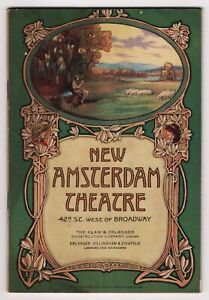
Sold on eBay March 20th, 2024
W. C. Fields "ZIEGFELD FOLLIES" Fanny Brice / Irving Berlin 1920 Playbill
This is a rare August 30th, 1920 program (playbill) from the Original Broadway production of the Fourteenth Annual Edition of the "ZIEGFELD FOLLIES" ("A National Institution") at the New Amsterdam Theatre in New York City. (The Fourteenth Edition opened June 22nd, 1920 and closed October 16th, 1920 after 123 performances.) ..... The "ZIEGFELD FOLLIES" were the most lavish musical productions on Broadway between 1907 and 1931. Blending beauty, music and talent with over 100 graceful and elegant "Ziegfeld Girls" in priceless gowns, jewels and flowers, audiences knew they would be treated to the most memorable evening possible. The key to the ongoing success of the "Follies", even in the worst of times was producer FLORENZ ZIEGFELD, Jr. ..... With music and lyrics by IRVING BERLIN, this edition starred W. C. FIELDS, FANNIE BRICE, RAY DOOLEY, MORAN and MACK, MARY EATON, VAN and SCHENCK, CARL RANDALL and JACK DONAHUE and included CHARLES WINNINGER, BERNARD GRANVILLE, BARBARA DEAN, GLADYS LOFTUS, ELEANOR DELL, MARGARET MORRIS, ALBERTINE MARLOWE, IRENE PALMER, ALTA KING, EVA BRADY, BETTY MORTON, ETHEL HALLOR, BEATRICE MILNER, CHARLOTTE WAKEFIELD, AVONNE TAYLOR, OLIVE VAUGHAN, FLORENCE WARE, HELEN SHEA, DORIS EATON, JOHN STEEL, MARGARET IRVING, DELYLE ALDA, EMILY DRANGE, JESSIE REED, ADDISON YOUNG, WILLIAM BLANCHE, JACK MAHAN, the SIX LITTLE FOLLIES GIRLS and THE FOLLIES BOYS ..... CREDITS: Music and Lyrics by IRVING BERLIN ("Annie Get Your Gun", "Music Box Revues", the Marx Brothers' "The Cocoanuts", "Louisiana Purchase", "This is the Army", "Miss Liberty", "Call Me Madam", "Mr. President"); Additional Music and Lyrics by GENE BUCK and DAVE STAMPER; Special Music by VICTOR HERBERT; Sets designed by JOSEPH URBAN; Costumes designed by Madame FRANCIS; Staged by EDWARD ROYCE; Produced by FLORENZ ZIEGFELD, Jr. ..... DETAILS: This 56 page playbill measures 5 1/4" X 7 3/4" inches and includes full production credits, cast list, scenes, musical numbers and wonderful vintage advertising, but no cast photos or bios ..... CONDITION: With the exception of light soiling to the cover and moderate edge wear, this rare playbill is in excellent condition and will make a wonderful addition to the collection of any musical theatre aficionado or historian. This item will be carefully packaged in a protective, carded sleeve and backed by stiff cardboard.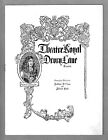
Sold on eBay July 30th, 2024
Mlle. ANNA PAVLOWA (Pavlova) Ballet Russe / Royal Drury Lane 1920 London Program
This is a rare April 19th, 1920 programme from the engagement of Russian Premiere Ballerina ANNA PAVLOWA and her Ballet Russe at the Theatre Royal, Drury Lane in London ..... The engagement starred the Incomparable ANNA PAVLOWA who was assisted by ALEXANDRE VOLININE, IVAN CLUSTINE (Balletmaster), Mlle. HILDA BUTSOVA, Fr. VAJINSKI, H. STOWITTS, J. ZALEWSKI, M. PIANOWSKI and CORPS DE BALLET of fifty dancers and a sixty member orchestra. The orchestra was conducted by THEODORE STIER. The repertoire included "THE SLEEPING BEAUTY", "THE WALPURGIS NIGHT" and several Divertissements ..... Biographical Note: Mlle. ANNA PAVLOVA (1881-1931) is widely regarded as one of the finest classical ballet dancers in history and was most noted as a Principal artist of the Imperial Russian Ballet and the Ballets Russes of Serge Diaghilev. Pavlova is most recognized for the creation of the rôle "The Dying Swan" and with her own company, would become the first ballerina to tour ballet around the world. Pavlova's passion for the art of ballet was realized when her mother took her to a performance of Marius Petipa's original production of The Sleeping Beauty at the Imperial Mariinsky Theatre. The lavish spectacle made an impression on the young Pavlova, and at the age of eight her mother took her to audition for the renowned Imperial Ballet School where she was finally accepted at age ten. Upon graduating, she began to perform at the Mariinsky Theatre, debuting on September 19th, 1899. In 1907, Anna Pavlova began her first tour, to Moscow, and by 1910 was appearing at the Metropolitan Opera House in America, making her debut in "Coppelia" in March 1910. In 1914, she was traveling through Germany on her way to England when Germany declared war on Russia. At that time, her connection to Russia was for all intents broken. For the rest of her life, Anna Pavlova toured the world with her own company and kept a home in London, where her exotic pets were constant company when she was there. While her contemporary, Isadora Duncan, introduced revolutionary innovations to dance, Anna Pavlova remained largely committed to the classic style. She was known for her daintiness, frailness, lightness and both wittiness and pathos. Her last world tour was in 1928-29 and her last performance in England in 1930. Anna Pavlova appeared in a few silent films: one, The Immortal Swan, she shot in 1924 but it was not shown until after her death. Anna Pavlova died of pleurisy in the Netherlands in 1931. (Reprinted in part from the website About.com.) ..... PROGRAM DETAILS: The oversized twelve page program measures 7 3/8" X 9 7/8" inches and includes full production credits, the performance repertoire, the names of the dancers and wonderful vintage advertising as well as photos of ANNA PAVLOVA, ALEXANDRE VOLININE, VERA KARALLI and IVAN CLUSTINE (last scanned image) ..... CONDITION: With the exception of heavy creasing, light soiling and minor edge wear, this rare program is in excellent condition and will make a wonderful addition to the collection of any classical music aficionado or dance historian. This item will be carefully packaged in a protective, carded sleeve and backed by stiff cardboard.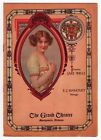
Sold on eBay May 8th, 2024
Ching Ling Foo "GERTRUDE HOFFMANN'S NEW REVUE" 1913 Montgomery, Alabama Program
This is a rare November 19th, 1913 program (playbill) from the one-night (two performances) engagement of GERTRUDE HOFFMANN in Her Own "NEW SPECTACULAR REVUE" at the Grand Theatre in Montgomery, Alabama ..... Originated and Staged by Miss Hoffmann, the revue opened with LEONINO from the Apollo Theatre in Vienna, Austria and the World Famous Chinese Magician CHING LING FOO, by special arrangement with George and Leon Mooser of Shanghai. "GERTRUDE HOFFMANN'S NEW REVUE" starred GERTRUDE HOFFMANN who included in her act impersonations of EDDIE FOY, GEORGE M. COHAN, GABY DESLYS, ANNA HELD, HARRY LAUDER, EVA TANGUAY, ETHEL BARRYMORE, Mme. IDA RUBENSTEIN and ISADORA DUNCAN. Miss Hoffmann was supported by CATHERINE WILSON, OLGA ZAICEFF, HELEN KERLIN, EMMA CUNNINGHAM, DeFOREST LA FLEUR, GERTRUDE ROLAND, MARJORIE ROLAND, LILLIAN DREWRY, MILDRED LA GAY, ROCHEN BAKER, DORIS LLOYD, MARGUERITE CRITTENDEN, LEE CHAPIN, BILLY MACON, JACK CLINTON, STAFFORD PEMBERTON, ESTELLE VERNON and JULIA CARLE. Produced by F. RAY COMSTOCK and MORRIS GEST, the revue was staged by GERTRUDE HOFFMANN with the orchestra conducted by MAX HOFFMANN ..... Biographical note: American vaudeville dancer and choreographer GERTUDE HOFFMANN (sometimes spelled Hoffman) was born Catherine Gertrude Hayes on May 7th, 1885 in San Francisco, California. At her mother's urging, Gertrude – whose early stage name was "Kitty" – took dancing lessons as a young girl and soon began auditioning for roles in the local theaters. She made her vaudeville debut in 1899 at Frederic Belasco's Alcazar Theatre. Gertrude met composer and arranger Max Hoffmann while touring as a dancer, and the two married in 1901. Hoffmann started out as a dancer and impressionist on the vaudeville stage; in her early years she performed imitations of other, more famous performers, including Eva Tanguay and Anna Held. Hoffmann worked with the latter in Florenz Ziegfeld, Jr.'s "A Parisian Model" in 1906, shocking many by dressing in drag and dancing with Held. She made her first major impression on audiences in 1908, with her rendition of the then-popular "Dance of the Seven Veils," adapted from the biblical story of "Salome". Hoffmann was repeatedly arrested while touring the United States with the dance, although some historians suggest that the arrests were arranged by vaudeville impresario Oscar Hammerstein to drum up publicity. Despite the scandals, this period marked Hoffmann's change of focus from dancing as entertainment to dancing as a high art. Hoffmann also gained fame when she partnered with theatrical producer Morris Gest to introduce American audiences to the much-lauded Russian ballet company, the "Ballets Russes", in 1911 by hiring European dancers to perform pieces from the company, albeit without choreographer Michel Fokine's permission. Hoffmann continued to perform through the 1910's, although by the mid-1920's she had largely given up her role as a dancer to concentrate instead on directing and choreographing her own group. She formed the Gertrude Hoffmann Girls dance troupe during this time – a chorus line of up to 25 dancing girls whose stage act also included fencing and aerial acrobatics. This group performed on New York stages as well as at Paris' famed Moulin Rouge nightclub through the mid-1930's. (Reprinted in part from the Center for Brooklyn History website) ..... The program also includes the credits for the one-night, Pre-Broadway engagement of the new RACHEL CROTHERS play "YOUNG WISDOM" starring MABEL and EDITH TALIAFERRO on November 20th, 1913. (The Original Broadway production would open January 5th, 1914 at the Criterion Theatre in New York City and run for 56 performances.) ..... MABEL and EDITH TALIAFERRO were supported by AUBREY BEATTIE, MABEL BERT, JUNIUS MATTHEWS, HAYWARD GINN, RICHARD STERLING, REGAN HUGHSTON and LOUIS LA BEY ..... CREDITS: Book by RACHEL CROTHERS; Directed by ROBERT MILTON; Produced by JOSEPH BROOKS ..... DETAILS: The twelve page program measures 6 1/8" X 8 3/4" inches and includes beautiful cover graphics, production credits, cast lists, synopsis of scenes, program notes, schedule of upcoming attractions and wonderful vintage advertising, but no photos or bios ..... CONDITION: With the exception of soiling to the back cover, a diagonal crease and moderate edge wear, this rare playbill is in excellent condition and will make a wonderful addition to the collection of any theatre aficionado or historian. This item will be carefully packaged in a protective, carded sleeve and backed by stiff cardboard.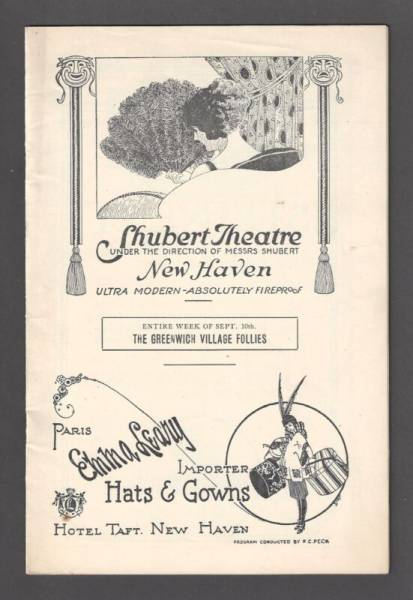
Sold on eBay October 17th, 2024


